Share these resources with potential adopters, shelter staff, volunteers, and fosters to help them to understand how to take over care and maintain the progress of a cat or kitten coming to them that has been through this taming/socialization process. This could prevent back-sliding and returns.
Subscribe to our YouTube channel, to get each new video that we make.
Check out our Taming Blog addressing lots of issues about living with feral cats and kittens.
Below is a crash course version of the Urban Cat League Taming Techniques. Download printer-friendly version.
Some Helpful Guidelines for Taming Feral Kittens
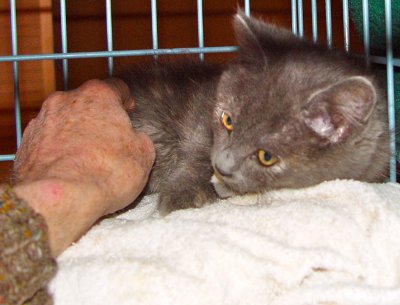
Kittens under 8 weeks can usually be socialized without much difficulty following the guidelines detailed below. Kittens over 8 weeks of age who’ve had no positive interaction with humans often take much longer to socialize. However, these same guidelines are often effective up to 6 months and often even with adult ferals.

Location – The best places to socialize kittens are anywhere where the socializer can get on the same level and comfortably interact with the kittens without the kittens feeling towered over, “backed into a corner,” or hiding out of reach. Many large-dog kennels are roomy enough for the socializer to sit inside and have the added advantage of more frequent exposure to typical human activity if placed in a busy room of the house. Most bathrooms work very well although they are isolated from continual household activity. A small room without hiding spots under couches and beds or behind furniture can also work very well. Radio and television sounds can contribute to getting outdoor ferals accustomed to the indoor environment.
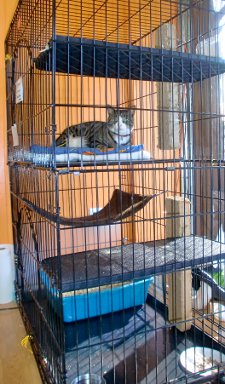
The double decker wire catteries on wheels can work very well to start socialization but at some point you must let the kittens out in a confined space where they can choose to approach you. They can be wheeled into a small room to be let out for hands on work or wheeled back into the living area for exposure to general activity between socialization sessions. Try to choose the set up which gives the kittens the most “quality” exposure to you and household activity.
Small cages or carriers don’t work well since the cats always feel cornered when we reach in and they have no room to make the important “mind shift” where THEY choose to approach US out of self-interest in order to get the food they desire. They need to have the option NOT to be near you in order to make that decision to approach.
CATS SOCIALIZE THEMSELVES BY CHOICE. We only provide the incentive… FOOD!
FOOD is the most important tool to facilitate the socialization process. Growing kittens have an insatiable appetite which will give them the courage to approach you and be touched when they might normally never allow you anywhere near them. NEVER put food down and walk away. It takes away any incentive for them to welcome you into their world. NO FREE RIDES!
The following guidelines are not “hard, fast rules.” You may find that the kittens skip to advanced stages very quickly or you may find they follow a sequence of their own design.
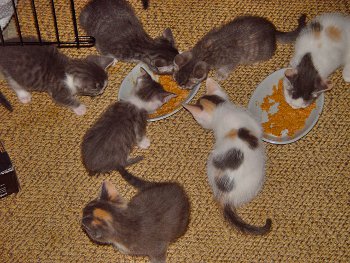
- Evaluation – If the kittens are healthy, using the litter box, and will eat in front of you, you can safely begin delaying meals just enough to give you the advantage of hunger. (If not, you may decide to give them a “free ride” until this situation stabilizes. Once they seem calmer or the vet gives the OK, you may begin the “tough love” stage of socialization where you space out the meals so that the kittens are eager to learn.)
- Tough Love – To repeat, NEVER put food down and walk away once the kittens are confident to eat with you at a distance. Inch the bowl progressively closer to you with each meal. Stay with the kittens until they have finished eating and then take any remaining food away with you when you leave. Always leave fresh water of course, but NO FOOD (wet or dry) when you are not sitting there with them. Watch the full-length workshop video for all of the important details.
- Eating off your finger – When the kittens have progressed to eating from a dish right beside you with your hand touching the dish, start offering something tasty from your hand. Gerber #2 Chicken Baby Food is one favorite we use. You can try this handfeeding sooner if they don’t want to come up that last distance up to your side to eat. Be flexible to keep them coming closer, but don’t let them hold you hostage at their level of comfort. Give a free taste of the Baby Food in the jar’s lid or dish to get them “hooked” and also to learn that they should lick this new food, and not chomp (your finger). Now you are ready to offer some off your finger. Your hand reaching close to them, without them retreating in fear is the lesson that they are learning through hand feeding. Find something they love and can’t resist.
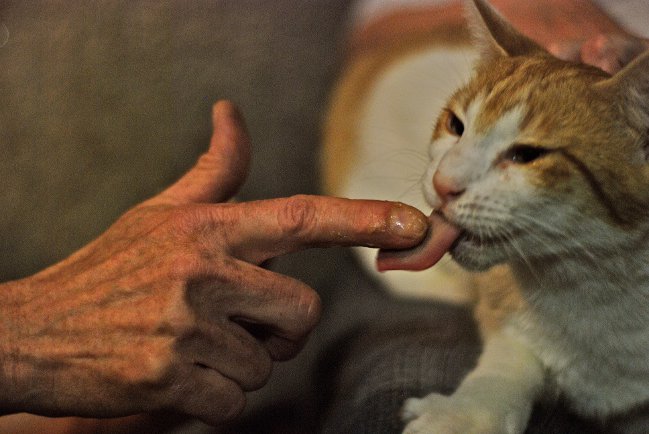
The order is of no importance as long as they are improving on some level. Be flexible but don’t let them hold you hostage at the stage of their choice. “Get tough,” and make them work for it. Until they realize the Baby Food’s consistency, they may want to gulp bites before they learn to lick it. Let them learn to lick from a spoon, popsicle stick or tongue depressor if they want to chew your finger instead of lick at first. They figure out to lick not bite quickly, but in the meantime, ouch! Your hand reaching close to them, without them retreating in fear is the lesson they are learning through hand feeding. - Lead them onto your lap – Once they are used to eating off your finger, use that to lead them up into contact with your body by their choice. You can also try putting a dish in your lap and let the entire litter climb up onto you to eat. The braver ones will start and the shy ones may need to be worked with individually at their level. Lead the braver ones as close as possible and see if they will make eye contact with you while licking from your finger. That’s a biggie for them! Put the fast learners in a carrier to work with the shier ones. Put a dish inside and close the door on them, if they aren’t quite ready to be picked up easily.
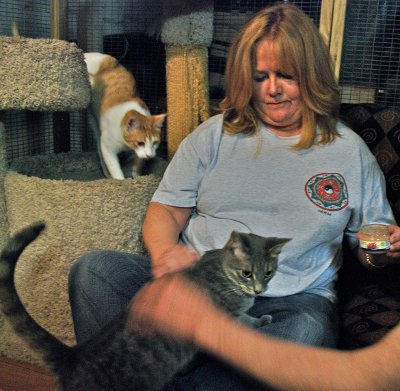
- Initiate Contact – Initiate contact at the beginning of a session where the kittens are particularly hungry and eagerly engrossed in eating. Start with them eating from a dish or while eating off the finger and eventually progress to touching them and petting while they are in your lap eating. Start in the head and shoulder area only. If s/he runs off, lure them back with baby food on the finger and any bad experience should be soon forgotten. (This approach to handle mistakes works at any stage. Back up to a stage that they’ve mastered and work back up to where they “freaked-out.” Don’t stop the session until they’ve forgotten the bad experience and are happily doing one of the steps with which they feel comfortable.)
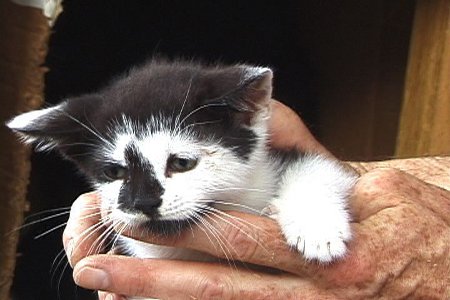
Check out the video footage of these techniques in action in the accompanying video to this page. - Preparation for lifting – Expand petting and touching around the head and shoulders by moving to touching the underbelly to desensitize them for being picked up. Also try nudging them from one side to the other while they are engrossed in eating. Just having your hands near them and gently pushing them around is an important preparation to being picked up.
- Moving on the ground – Set up two dishes and gently lift/scoot a kitten the short distance from one dish to the other, very close to the ground. If the kitten is engrossed in eating s/he won’t mind being lifted if it goes smoothly and quickly. If not, lure ’em back, back up and start over.
- Picking them up – Start sitting on the floor so the first real lift is still close to the floor from their point of view. Have a full jar of baby food opened and ready before you try the first pick-up. Try it when they are engrossed in eating right next to you rather than scrambling after them on the run. Lift them under their chest with a small dish of food RIGHT IN FRONT OF THEIR NOSE the whole time. Hold them as loosely as possible onto your knees and eventually to your chest. Young kittens are often reassured if they feel the warmth of your body and can feel your heart beat when held against your chest. If it works you can try it up onto your knees the next day and eventually standing up. Make sure they are very comfortable with the small lifts before you ever bend down from towering above them and picking them up fully standing. When you can do that, you’re home free!
- Handling w/o food – After a good long session where the kitten(s) are very full and getting sleepy, try gentle petting and work up to holding and petting without the incentive of food being present.
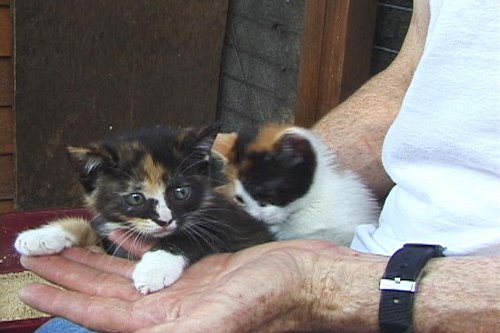
If this works you should be able to try it at other times between meals. It may be hardest just before feeding when the kittens are very hungry and confused and stressed by being held when they have only food on their minds. There’s usually at least one “love bug” in every litter that will give you hope for the others. - Transition to adoption – Before putting them in a cage in an adoption center, test them with a few different socializers. If the volunteers at the adoption center can continue the baby food training there is often a smooth transition. Older and especially shy kittens do better when they go directly to an adoption and bypass the adoption center altogether. A crash course in socializing for the adopting family may be needed to assure that the transition to the home goes well. If the adopter starts them in the bathroom rather than turning the kittens loose to the run of the house, it will assure that they can bond with the kittens and that the kittens will know where the litter box is. If not the kittens often run off under the couch to hide for the foreseeable future. Give them a copy of this so they can understand what they kittens have accomplished and how they can continue the progress.
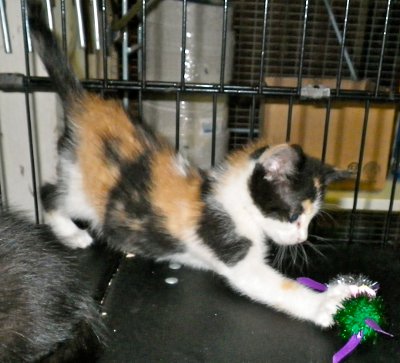
INTERACTIVE PLAY – “Most” feral kittens are frightened by interactive play when first exposed to humans. There is no rule for when to introduce it, or when they will accept it, but the best way to start is with a toy which isn’t too threatening. A string on the end of a stick or some toy that allows you to entice them from a distance, allows them to get involved with your game without being face to face with you. Some people have found that interactive play was the breakthrough activity much more so than using food. Be flexible to discover what breaks the ice best and branch out from that. Use whatever proves to be their favorite thing as a reward for new steps or to break through a plateau. Once a step has been mastered, only offer regular food as a reward for that step saving the favorite treat for breaking into new territory. Remember the Mantra “Tough Love.”


